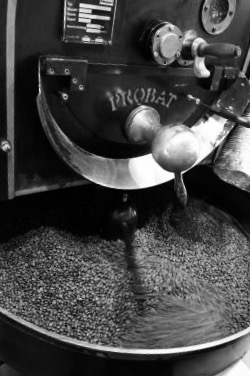The first known implements for roasting coffee beans were thin, circular, often perforated pans made from metal or porcelain, used in the 15th century in the Ottoman Empire and Greater Persia. This type of shallow, dished pan was equipped with a long handle so that it could be held over a brazier (a container of hot coals) until the coffee was roasted. The beans were stirred with a slender spoon. Only a small amount of beans could be heated at one time.The first cylinder roaster with a crank to keep the beans in motion appeared in Cairo around 1650. It was made of metal, most commonly tinned copper or cast iron, and was held over a brazier or open fire. French, Dutch and Italian variations of this design quickly appeared. These proved popular over the next century in Europe, England and the American colonies.
In the 19th century, various patents were awarded in the U.S. and Europe for commercial roasters, to allow for large batches of coffee. Nevertheless, home roasting continued to be popular. A man working at a commercial roasting plant beginning in the 1850s in St. Louis, Missouri, said that “selling roasted coffee was up-hill work, as everyone roasted coffee in the kitchen oven.”Appliances catering to the home roaster were developed; in 1849 a spherical coffee roaster was invented in Cincinnati, Ohio, for use on the top of a wood-fired kitchen stove, fitted into a burner opening. Green beans were available at the local general store, or even through mail order.For roasting, many people used such simple methods as a layer of beans on a metal sheet in the oven, or beans stirred in a cast iron skillet over a fire. Despite the wide popularity of home roasting, Burns felt that it would soon disappear because of the great strides made in commercial roasting in the 1860s and 1870s, including the benefits of the economies of scale. The commercial roaster inventions patented by Burns revolutionized the U.S. roasting industry,much like the innovations of inventors in Emmerich am Rhein greatly advanced commercial coffee roasting in Germany.As well, the 1864 marketing breakthrough of the Arbuckle Brothers in Philadelphia, introducing the convenient one-pound (0.45 kg) paper bag of roasted coffee, brought success and imitators.From that time commercially roasted coffee grew in popularity until it gradually overtook home roasting during the 1900s in America.In 1903 and 1906 the first electric roasters were patented in the U.S. and Germany, respectively; these commercial devices eliminated the problem of smoke or fuel vapor imparting a bad taste to the coffee.
In France, the home roaster did not yield to the commercial roaster until after the 1920s, especially in rural areas. Coffee was roasted to a dark color in small batches at home and by shopkeepers, using a variety of appliances including ones with a rotating cylinder of glass, sheet iron or wire mesh, and ones driven by hand, clockwork or electric motor. Because of the smoke and blowing chaff, country dwellers generally roasted outdoors.

